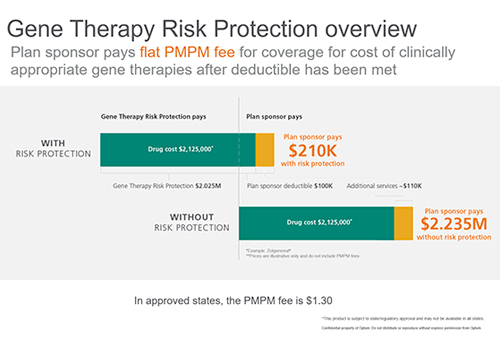In November 2018, the news broke that a scientist in China had evaded all the relevant regulatory barriers to produce the world’s first genetically-edited babies.1
This act was widely condemned in professional circles as reckless and unethical.2 The news also brought widespread public attention to CRISPR, the cutting-edge technology that was used to produce the genetically-altered embryos. In this article we want to look past the sensational news out of China, and focus more on the perfectly legitimate ways that CRISPR could revolutionize the drug world and the corresponding implications for plan sponsors.
What is CRISPR?
Like people, bacteria need an immune system. Clustered Regularly Interspaced Short Palindromic Repeats are a naturally-occurring genetic sequence native to the immune systems of certain bacteria. When a virus invades the bacteria for the first time, the CRISPR sequence allow the bacteria to "remember" the virus.3 If the virus attacks again, the CRISPR array produces RNA segments to target the virus as well as an enzyme known as cas9 to chop up the viral DNA.3
While researchers have been able to alter the genome of certain organisms for the past few decades, this was only possible with great time and effort. In 2012, scientists realized that CRISPR could be re-purposed as a quicker, easier, more precise way to edit DNA.4 This discovery unlocked a vast new realm of possibilities.
What advantages can CRISPR provide?
The single greatest advantage of CRISPR is that it has taken gene editing out of the hands of molecular biologists and made it accessible to a broader array of researchers. Since this discovery, new companies have been founded to leverage CRISPRs ability to reliably alter genes in almost any organism.
As we saw in China, making these tools widely available (and relatively inexpensive) comes with moral and ethical concerns.
Controversial activities such as those in China tend to obscure the most immediate and beneficial applications of CRISPR. For example, these technologies are already becoming an important part of the drug development tool kit. Here are three ways CRISPR is already making an impact in the pharmaceutical industry, or will soon:
- CRISPR can improve existing therapies
As we’ve noted, CAR T therapy is an important advance in how we treat certain forms of cancer. CAR T treatment involves taking naturally occurring infection-fighting cells, called T cells, genetically modifying them, and then putting the altered cells back in the body where they can attack cancer cells.
One potential drawback of super-charging T cells is the risk that these cells may attack healthy cells as well as cancer cells, which can result in organ damage.5 Also currently-approved CAR T therapies are indicated for blood cancers such as leukemia but are not yet approved for patients with solid tumors.6
Gene editing technologies such as CRISPR may help create the next generation of CAR T therapies.7 In addition to broadening the available targets beyond blood cancers, a next generation CAR T therapy could reduce the likelihood of harming healthy cells.6 A CRISPR-derived, universal CAR T therapy is another possibility.7
- CRISPR can help find drug targets
- CRISPR can help test drug candidates
Using CRISPR, researchers can activate or inhibit the function of genes, essentially turning the genes “on” and “off” to determine which proteins cause or prevent a given disease. Given a systemic way to “knock out’ genes one-by one, researchers are better able to understand the complex interactions between multiples genes and the proteins they encode for. 8
CRISPR has also enabled researchers to explore new parts of the human genome. For decades, many scientists considered the parts of the genome that does not encode for proteins to be “junk DNA” and therefore not a good candidate for drug development.9
Estimated to make up 98% of your DNA, this “dark matter of the genome” may have regulatory functions that contribute to disease.10
One of the most crucial elements of drug development process is testing candidate drugs for efficacy and toxicity. For ethical reasons, this testing is rarely done in living people. Instead, researchers rely on cell and animal models of the human diseases they seek to cure.11
Yet, all too often, a drug in development will show great promise when tested in mice or monkeys, but then fail to work in humans. CRISPR technologies can help researchers build more sophisticated cellular models that will more accurately reflect how humans might respond to a new treatment.12
Cost concerns and future uses
It is important to pause here to note that CRISPR-related technologies are still very new and despite the many advantages they promise in the lab, it will be difficult and time-consuming to translate CRISPR-based therapies into FDA-approved, market-ready products.
Indeed, the first therapies created using CRISPR technology are just now entering clinical trials. In February, pharmaceutical companies CRISPR Therapeutics and Vertex said that a human patient has been administered a CRISPR-derived treatment targeting the rare blood disease, beta thalassemia.13 Later in the year, the drug will be administered in a trial to patients with sickle cell disease.13
While it is too early to know the ultimate fate of these specific therapies, we can begin to approximate potential costs. CRISPR-derived therapies are being developed for a wide range of diseases but it is likely that the first drugs to make it to market will be for rare diseases. Judging by existing costs for orphan drugs and gene therapies, one can reasonably expect CRISPR-derived drugs to be very expensive. For example, the gene therapy Luxturna™, which treats a form of hereditary blindness, launched at $425,000 per eye.14
Another consideration is the patent issues surrounding CRISPR.15 As we have seen in the case of biologic drugs and biosimilars, patents will allow developers of CRISPR therapies to charge elevated prices for an extended period of time. Therefore, it’s tough to say exactly when CRISPR-enabled advances will make it to the market and at what cost.
OptumRx is dedicated to tackling the biggest challenges in health care. We will continue to monitor developments related to CRISPR.
Related content
References
- MIT Technology Review. “Chinese scientists are creating CRISPR babies.” Accessed at: https://www.technologyreview.com/s/612458/exclusive-chinese-scientists-are-creating-crispr-babies/
- Science Translational Medicine. After such knowledge. Accessed at: http://blogs.sciencemag.org/pipeline/archives/2018/11/28/after-such-knowledge?_ga=2.134701361.1540807166.1547506883-1865045105.1547506883
- U.S. National Library of Medicine. “What are genome editing and CRISPR-Cas9?” Accessed at: https://ghr.nlm.nih.gov/primer/genomicresearch/genomeediting
- Science. “A Programmable Dual-RNA–Guided DNA Endonuclease in Adaptive Bacterial Immunity.” Accessed at: http://science.sciencemag.org/content/337/6096/816
- Blood. “Toxicities of chimeric antigen receptor T cells: recognition and management.” Accessed at: http://www.bloodjournal.org/content/127/26/3321?sso-checked=true
- Nature. “CAR-T cells: the long and winding road to solid tumors.” https://www.nature.com/articles/s41419-018-0278-6
- Molecules and Cells. “Unleashing the Therapeutic Potential of CAR-T Cell Therapy Using Gene-Editing Technologies.” Accessed at: https://www.ncbi.nlm.nih.gov/pmc/articles/PMC6125425/
- Science. “Genome-Scale CRISPR-Cas9 Knockout Screening in Human Cells.” Accessed at: http://science.sciencemag.org/content/343/6166/84
- Nature Biotechnology. “CRISPR-Cas9 epigenome editing enables high-throughput screening for functional regulatory elements in the human genome.” Accessed at: https://www.ncbi.nlm.nih.gov/pubmed/28369033
- Phys.org. “The mysterious 98%: Scientists look to shine light on the 'dark genome.'” Accessed at: https://phys.org/news/2017-02-mysterious-scientists-dark-genome.html
- Journal of Pathology. “Engineering large animal models of human disease.” Accessed at: https://www.ncbi.nlm.nih.gov/pmc/articles/PMC4737318/
- Trends in molecular medicine. “Modeling disease in vivo with CRISPR/Cas9.” Accessed at: https://www.ncbi.nlm.nih.gov/pmc/articles/PMC4592741/
- CRISPR Therapeutics. “CRISPR Therapeutics and Vertex Announce Progress in Clinical Development Programs for the Investigational CRISPR/Cas9 Gene-Editing Therapy CTX001.” Accessed at: http://www.crisprtx.com/about-us/press-releases-and-presentations/crispr-therapeutics-and-vertex-announce-progress-in-clinical-development-programs-for-the-investigational-crispr-cas9-gene-editing-therapy-ctx001
- CNBC. “A US drugmaker offers to cure rare blindness for $850,000.” Accessed at: https://www.cnbc.com/2018/01/03/spark-therapeutics-luxturna-gene-therapy-will-cost-about-850000.html
- Yale Journal of Biology and Medicine. “CRISPR, Patents and Public Health.” Accessed at: https://www.ncbi.nlm.nih.gov/pmc/articles/PMC5733839/
STATEMENT REGARDING FINANCIAL INFLUENCE:
This article is directed solely to its intended audience about important developments affecting the pharmacy benefits business. It is not intended to promote the use of any drug mentioned in the article and neither the author nor OptumRx has accepted any form of compensation for the preparation or distribution of this article.



